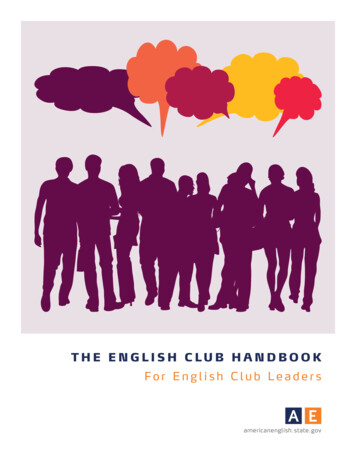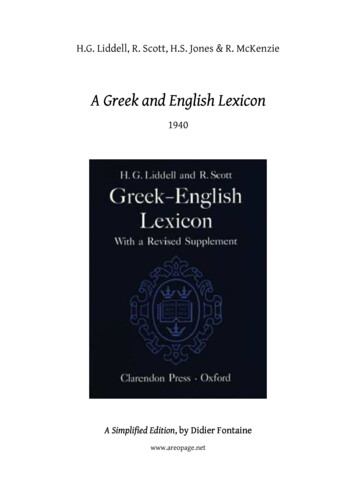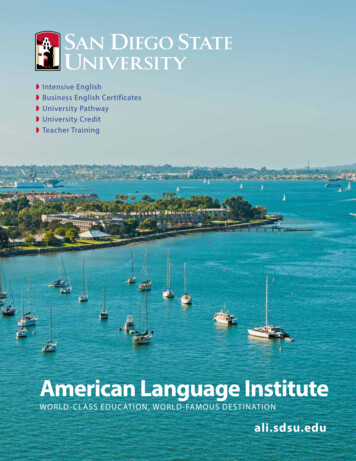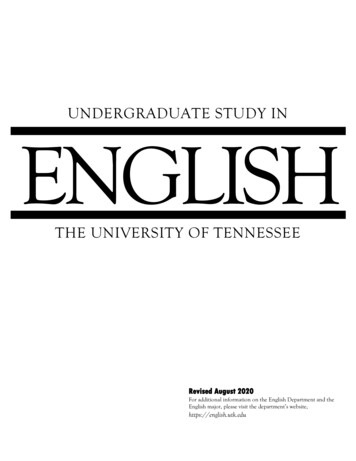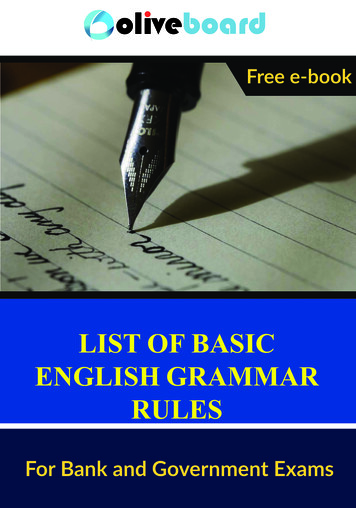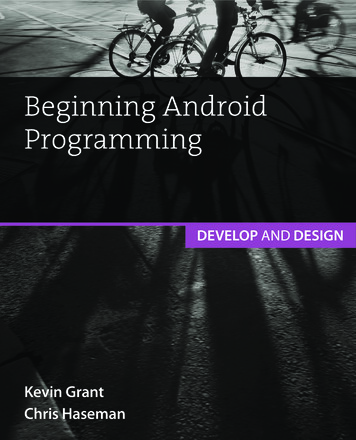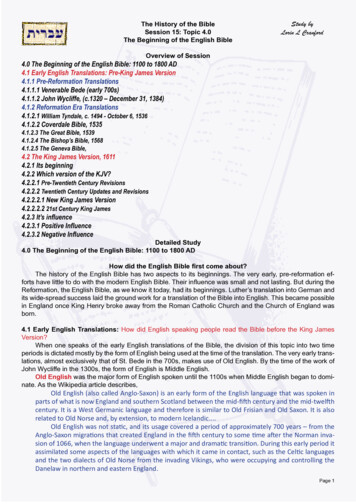
Transcription
The History of the BibleSession 15: Topic 4.0The Beginning of the English BibleStudy byLorin L CranfordOverview of Session4.0 The Beginning of the English Bible: 1100 to 1800 AD4.1 Early English Translations: Pre-King James Version4.1.1 Pre-Reformation Translations4.1.1.1 Venerable Bede (early 700s)4.1.1.2 John Wycliffe, (c.1320 – December 31, 1384)4.1.2 Reformation Era Translations4.1.2.1 William Tyndale, c. 1494 - October 6, 15364.1.2.2 Coverdale Bible, 15354.1.2.3 The Great Bible, 15394.1.2.4 The Bishop’s Bible, 15684.1.2.5 The Geneva Bible,4.2 The King James Version, 16114.2.1 Its beginning4.2.2 Which version of the KJV?4.2.2.1 Pre-Twentieth Century Revisions4.2.2.2 Twentieth Century Updates and Revisions4.2.2.2.1 New King James Version4.2.2.2.2 21st Century King James4.2.3 It’s influence4.2.3.1 Positive Influence4.2.3.2 Negative InfluenceDetailed Study4.0 The Beginning of the English Bible: 1100 to 1800 ADHow did the English Bible first come about?The history of the English Bible has two aspects to its beginnings. The very early, pre-reformation efforts have little to do with the modern English Bible. Their influence was small and not lasting. But during theReformation, the English Bible, as we know it today, had its beginnings. Luther’s translation into German andits wide-spread success laid the ground work for a translation of the Bible into English. This became possiblein England once King Henry broke away from the Roman Catholic Church and the Church of England wasborn.4.1 Early English Translations: How did English speaking people read the Bible before the King JamesVersion?When one speaks of the early English translations of the Bible, the division of this topic into two timeperiods is dictated mostly by the form of English being used at the time of the translation. The very early translations, almost exclusively that of St. Bede in the 700s, makes use of Old English. By the time of the work ofJohn Wycliffe in the 1300s, the form of English is Middle English.Old English was the major form of English spoken until the 1100s when Middle English began to dominate. As the Wikipedia article describes,Old English (also called Anglo-Saxon) is an early form of the English language that was spoken inparts of what is now England and southern Scotland between the mid-fifth century and the mid-twelfthcentury. It is a West Germanic language and therefore is similar to Old Frisian and Old Saxon. It is alsorelated to Old Norse and, by extension, to modern Icelandic.Old English was not static, and its usage covered a period of approximately 700 years – from theAnglo-Saxon migrations that created England in the fifth century to some time after the Norman invasion of 1066, when the language underwent a major and dramatic transition. During this early period itassimilated some aspects of the languages with which it came in contact, such as the Celtic languagesand the two dialects of Old Norse from the invading Vikings, who were occupying and controlling theDanelaw in northern and eastern England.Page 1
This sample of text from Matthew 6:9-13 provides some indication of the language:This text of The Lord’s Prayer is presented in thestandardized West Saxon literary dialect:Fæder ure þu þe eart on heofonum,Si þin nama gehalgod.To becume þin rice,gewurþe ðin willa, on eorðan swa swa on heofonum.urne gedæghwamlican hlaf syle us todæg,and forgyf us ure gyltas, swa swa we forgyfað urumgyltendum.and ne gelæd þu us on costnunge, ac alys us ofyfele. soþlice.New Revised Standard Version (Mt. 6:9-13)Our Father in heaven,hallowed be your name.Your kingdom come.Your will be done, on earth as it is in heaven.Give us this day our daily bread.And forgive us our debts, as we also have forgivenour debtors.And do not bring us to the time of trial, but rescueus from the evil one.Middle English developed in large part from the Norman invasion of England in 1066 AD. It joined a mixtureof different languages current in the British Isles until the mid to late 1400s, when another shift took placelinguistically. A very helpful summation is found in the Wikipedia article on Middle English:Middle English is the name given by historical linguistics to the diverse forms of the English language spoken between the Norman invasion of 1066 and the mid-to-late 15th century, when the Chancery Standard, a form of London-based English, began to become widespread, a process aided by theintroduction of the printing press into England by William Caxton in the 1470s, and slightly later byRichard Pynson. By this time the Northumbrian dialect spoken in south east Scotland was developinginto the Scots language. The language of England as spoken after this time, up to 1650, is known as EarlyModern English.Unlike Old English, which tended largely to adopt Late West Saxon scribal conventions in the immediate pre-Conquest period, Middle English as a written language displays a wide variety of scribal (andpresumably dialectal) forms. It should be noted, though, that the diversity of forms in written MiddleEnglish signifies neither greater variety of spoken forms of English than could be found in pre-ConquestEngland, nor a faithful representation of contemporary spoken English (though perhaps greater fidelityto this than may be found in Old English texts). Rather, this diversity suggests the gradual end of the roleof Wessex as a focal point and trend-setter for scribal activity, and the emergence of more distinct localscribal styles and written dialects, and a general pattern of transition of activity over the centuries whichfollow, as Northumbria, East Anglia and London emerge successively as major centres of literary production, with their own generic interests.Toward the end of the 1300s, English became increasingly the official governmental language as wellin the royal court of the king. As a result, a process of standardization of the language begins. This will lay abasic foundation for the language structure even as English continues to be used today. This sample of anearly and a late middle English translation of Luke 8:1-3 provides some sense of the language and the wayit evolved:Early Middle English TranslationLate Middle English TranslationSyððan wæs geworden þæt heferde þurh þa ceastre and þætcastel: godes rice prediciende andbodiende. and hi twelfe mid. Andsume wif þe wæron gehælede ofawyrgdum gastum: and untrumnessum: seo magdalenisce mariaofþære seofan deoflu uteodon:and iohanna chuzan wif herodesgerefan: and susanna and manega oðre þe him of hyra spedumþenedon;And it is don, aftirward Jesusmade iourne bi cites & castelisprechende & euangelisende þerewme of god, & twelue wiþ hym& summe wymmen þat weren helid of wicke spiritis & sicnesses,marie þat is clepid maudeleyn, ofwhom seuene deuelis wenten out& Jone þe wif off chusi procuratourof eroude, & susanne & manyeoþere þat mynystreden to hym ofher facultesNew Revised Standard VersionSoon afterwards he went onthrough cities and villages, proclaiming and bringing the goodnews of the kingdom of God. Thetwelve were with him, as well assome women who had been curedof evil spirits and infirmities: Mary,called Magdalene, from whom seven demons had gone out, and Joanna, the wife of Herod’s stewardChuza, and Susanna, and manyothers, who provided for them outof their resources.John Wycliffe’s translation (1395) of Luke 8:1-3 reflects the influence of the late middle English form ofthe language:Page 2
1 And it was don aftirward, and Jhesus made iourney bi citees and castels, prechynge and euangelisynge the rewme of God, and twelue with hym; 2 and sum wymmen that weren heelid of wickid spiritisand sijknessis, Marie, that is clepid Maudeleyn, of whom seuene deuelis wenten out, 3 and Joone, thewijf of Chuse, the procuratoure of Eroude, and Susanne, and many othir, that mynystriden to hym of herritchesse.4.1.1 Pre-Reformation TranslationsDuring this time period, when some isolated translations of the English Bible began appearing, oneshould remember that these translations are not made from the biblical languages text. Rather, they aretranslations of the Latin Vulgate into a particular form of the English language. Those who produce thesetranslations are inside the Roman Catholic church and are very loyal to it. Their concern was to help thepeople on the British Isles to better understand the gospel of Christ. And, in the case of Wycliffe, to also fosteran awareness of the teachings of the Bible by the laity. This was intended to create pressure on the Catholicchurch hierarchy to reform itself and pull the church back toward biblical based teachings.4.1.1.1 Venerable BedeBefore the Middle Ages, a few isolated efforts at translating the Vulgateinto Old English occurred. The better known work was that of St. Bede in theearly 700s. But the Latin Vulgate held such sway in the minds of most Christians in England that there was resistance to the idea of the Bible becomingtoo common for the laity. The Wikipedia article provides a summary:Although John Wycliff is often credited with the first translation of theBible into English, there were, in fact, many translations of large parts of theBible centuries before Wycliff’s work. Toward the end of the seventh century,the Venerable Bede began a translation of Scripture into Old English (alsocalled Anglo-Saxon). Aldhelm (AD 640–709), likewise, translated the complete Book of Psalms and large portions of other scriptures into Old English.In the 11th century, Abbot Ælfric translated much of the Old Testament intoOld English.For seven or eight centuries, it was the Latin Vulgate that held sway asthe common version nearest to the tongue of the people. Latin had become the accepted tongue of theCatholic Church, and there was little general acquaintance with the Bible except among the educated.During all that time, there was no real room for a further translation. Medieval England was quite unripefor a Bible in the mother tongue; while the illiterate majority were in no condition to feel the want ofsuch a book, the educated minority would be averse to so great and revolutionary a change. When aman cannot read any writing, it really does not matter to him whether books are in current speech ornot, and the majority of the people for those seven or eight centuries could read nothing at all.These centuries added to the conviction of many that the Bible ought not to become too common, that it should not be read by everybody, that it required a certain amount of learning to makeit safe reading. They came to feel that it is as important to have an authoritative interpretation of theBible as to have the Bible itself. When the movement began to make it speak the new English tongue, itprovoked the most violent opposition. Latin had been good enough for a millennium; why cheapen theBible by a translation? There had grown up a feeling that Jerome himself had been inspired. He had beencanonised, and half the references to him in that time speak of him as the inspired translator.Criticism of his version was counted as impious and profane as criticisms of the original text couldpossibly have been. It is one of the ironies of history that the version for which Jerome had to fight, andwhich was counted a piece of impiety itself, actually became the ground on which men stood when theyfought against another version, counting anything else but this very version an impious intrusion.How early the movement for an English Bible began, it is impossible now to say. Yet the fact is thatuntil the last quarter of the fourteenth century, there was no complete prose version of the Bible in theEnglish language. However, there were vernacular translations of parts of the Bible in England prior to inboth Anglo Saxon and Norman French.Unfortunately, none of his translation work has survived. Consequently, we have no access to any of thisin order to gain a clear sense of how he did this work.Page 3
4.1.1.2 John Wycliffe, (c.1320 – December 31, 1384)The most important pre-reformation Bible translator in the English speaking world wasJohn Wycliffe. Closely connected with the university at Oxford most of his adult life, he was apart of a movement that was critical of the papacy and other practices of the Roman CatholicChurch. This has earned him the label “Morning Star of the Reformation.” Wycliffe’s reformation activities are well summarized in the Wikipedia article:It was not as a teacher or preacher that Wycliffe gained his position in history; this camefrom his activities in ecclesiastical politics, in which he engaged about the mid-1370s, whenhis reformatory work also began. In 1374 he was among the English delegates at a peace congress atBruges. He may have been given this position because of the spirited and patriotic behavior with whichin the year 1366 he sought the interests of his country against the demands of the papacy. It seems hehad a reputation as a patriot and reformer; this suggests the answer to the question how he came to hisreformatory ideas. [Even if older evangelical parties did not exist in England before Wycliffe, he mighteasily have been influenced by continental “evangelicals.”]The root of the Wycliffite reformatory movement must be traced to his Bible study and to theecclesiastical-political lawmaking of his times. He was well acquainted with the tendencies of the ecclesiastical politics to which England owed its position. He had studied the proceedings of King Edward Iof England, and had attributed to them the basis of parliamentary opposition to papal usurpations. Hefound them a model for methods of procedure in matters connected with the questions of worldly possessions and the Church. Many sentences in his book on the Church recall the institution of the commission of 1274, which caused problems for the English clergy. He considered that the example of EdwardI should be borne in mind by the government of his time; but that the aim should be a reformation ofthe entire ecclesiastical establishment. Similar was his position on the enactments induced by the ecclesiastical politics of Edward III, with which he was well acquainted and are fully reflected in his politicaltracts.The sharper the strife became [with the papacy], the more Wycliffe had recourse to his translationof Scripture as the basis of all Christian doctrinal opinion, and expressly tried to prove this to be the onlynorm for Christian faith. In order to refute his opponents, he wrote the book in which he endeavored toshow that Holy Scripture contains all truth and, being from God, is the only authority. He referred to theconditions under which the condemnation of his 18 theses was brought about; and the same may besaid of his books dealing with the Church, the office of king, and the power of the pope – all completedwithin the space of two years (1378-79). To Wycliffe, the Church is the totality of those who are predestined to blessedness. It includes the Church triumphant in heaven, those in purgatory, and the Churchmilitant or men on earth. No one who is eternally lost has part in it. There is one universal Church, andoutside of it there is no salvation. Its head is Christ. No pope may say that he is the head, for he can notsay that he is elect or even a member of the Church.Needless to say, Wycliffe’s Bible translation work was part of a much larger agenda to reform theRoman Catholic Church. In particular, his desire was to force the RCC priesthoodand church back to the perceived days of poverty that he assumed characterized the ministry of Jesus and the apostles. This position became the centralmotivation for a movement known as the Lollards, which was both a political andreligious movement demanding a return to biblical principles for the priests. Oneof their beliefs, which was severely opposed by the church, was that piety wasthe sole basis for a priest being able to administer the sacraments, not officialordination by the Church. Given the massive ownership of property and politicalpower that the Church had over most all of Europe, such a position demandingpoverty was seen as extremely dangerous. Efforts to stamp out this influencewere severe, despite the popularity of Wycliffe’s ideas among many of the English nobility, and people in general.His translation was produced from 1380 to 1390 and released in segmentsuntil completed and released as a whole. Increasingly, it has become clear thatothers besides Wycliffe himself worked on this translation, although it bears hisname. The translation was based on the Latin Vulgate, not the biblical languagetexts. The form of English was middle English. Revisions of this translation reflectPage 4
changes in wording that move it closer to the very late forms of middle English, as the illustration below fromGenesis 1:3 demonstrates:Vulgate:Early Wyclif:Later Wyclif:King James:Dixitque Deus: Fiat lux, et facta est luxAnd God said: Be made light, and made is lightAnd God said: Light be made; and light was madeAnd God said: Let there be light; and there was lightHis rendering of John 3:16 is of particular interest:For God louede so the world that he yaf his oon bigetun sone, that ech man that beliueth in him perischenot, but haue euerlastynge lijf.By the completion of this translation project, Wycliffe’s translation was the first English translation of the entireBible. Thus the Wycliffe Bible marks the beginning of the English Bible.The impact of the Wycliffe translation was initially strong, but the intense opposition of the papacy and itsstrong-arm tactics succeeded in crushing its influence. Severe censorship laws were passed by the Englishparliament banning its distribution and reading. Preoccupation with wars with the French and other politicaleruptions pushed these religious issues to a back burner status for more than century, until Luther’s movement on the European continent gained success and opened the door for translation efforts in England toflourish again.4.1.2 Reformation Era TranslationsAgain, the emergence of the English Bible as a complete translation with Wycliffe begins then dies. TheProtestant Reformation in Europe was necessary before the English Bible could resurface, and with sufficientpopularity that it successfully resisted efforts to banish it. Just as Luther had recognized the importance of avernacular translation of the Bible into the language of the people (i.e., German), the Reformation era EnglishBible translators understood the same thing. By the 1500s the political atmosphere had changed, negativeattitudes by both the people and political leaders against the papacy had grown -- these and other aspectscreated the necessary environment for the English Bible as a part of the spread of the Protestant Reformationwestward across the English channel.4.1.2.1 William Tyndale, c. 1494 - October 6, 1536Tyndale’s biography is a tale of attempted reform and adherence to biblical principles at the cost of his life. The Wikipedia article provides a concisesummation:William Tyndale was born around 1494, probably in North Nibley near Dursley, Gloucestershire. The Tyndales were also known under the name “Hitchins” or“Hutchins”, and it was under this name that he was educated at Magdalen Hall, Oxford (now part of Hertford College), where he was admitted to the Degree of Bachelorof Arts in 1512 and Master of Arts in 1515. He was a gifted linguist (fluent in French, Greek, Hebrew,German, Italian, Latin, Spanish and of course his native English) and subsequently went to Cambridge(possibly studying under Erasmus, whose 1503 Enchiridion Militis Christiani - “Handbook of the ChristianKnight” - he translated into English), where he met Thomas Bilney and John Fryth.He became chaplain in the house of Sir John Walsh at Little Sodbury in about 1521. His opinionsinvolved him in controversy with his fellow clergymen and around 1522 he was summoned before theChancellor of the Diocese of Worcester on a charge of heresy. By now he had already determined totranslate the Bible into English: he was convinced that the way to God was through His word and thatscripture should be available even to ‘a boy that driveth the plough’. He left for London.Tyndale was firmly rebuffed in London when he sought the support of Bishop Cuthbert Tunstall.The bishop, like many highly-placed churchmen, was uncomfortable with the idea of the Bible in the vernacular. Tyndale, with the help of a merchant, Humphrey Monmouth, left England under a pseudonymand landed at Hamburg in 1524. He had already begun work on the translation of the New Testament.He visited Luther at Wittenberg and in the following year completed his translation.Following the publication of the New Testament, Cardinal Wolsey condemned Tyndale as a hereticand demanded his arrest.Tyndale went into hiding, possibly for a time in Hamburg, and carried on working. He revised hisNew Testament and began translating the Old Testament and writing various treatises. In 1530 he wrotePage 5
The Practyse of Prelates, which seemed to move him briefly to the Catholic side through its oppositionto Henry VIII’s divorce. This resulted in the king’s wrath being directed at him: he asked the emperorCharles V to have Tyndale seized and returned to England.Eventually, he was betrayed to the authorities. He was arrested in Antwerp in 1535 and held inthe castle of Vilvoorde near Brussels. He was tried on a charge of heresy in 1536 and condemned to thestake, despite Thomas Cromwell’s attempted intercession on his behalf. He was mercifully strangled, andhis dead body was burnt, on 6 October 1536. His final words reportedly were: “Oh Lord, open the Kingof England’s eyes.”His translation of both the Old andNew Testaments is a fascinatingstory intertwined with his tumultuous life:Tyndale was a priest who graduated at Oxford, was a student inCambridge when Martin Lutherposted his theses at Wittenbergand was troubled by the problemswithin the Church. In 1523, takingadvantage of the new invention of the printing machine Tyndale began to cast the Scriptures into thecurrent English.However, Tyndale did not have copies of “original” Hebrew texts. In fact the quality of the Hebrewdocuments was poor, since no original Hebrew sources earlier than the 10th Century had survived. Heset out to London fully expecting to find support and encouragement there, but he found neither. Hefound, as he once said, that there was no room in the palace of the Bishop of London to translate theNew Testament; indeed, that there was no place to do it in all England. A wealthy London merchant subsidized him with the munificent gift of ten pounds, with which he went across the Channel to Hamburg;and there and elsewhere on the Continent, where he could be hid, he brought his translation to completion. Printing facilities were greater on the Continent than in England; but there was such opposition tohis work that very few copies of the several editions of which we know can still be found. Tyndale wascompelled to flee at one time with a few printed sheets and complete his work on another press. Severaltimes copies of his books were solemnly burned, and his own life was frequently in danger.The Church had objected to Tyndale’s translations because in their belief purposeful mistranslations had been introduced to the works in order to promote anticlericalism and heretical views (thesame argument they used against Wycliff’s translation). Thomas More accused Tyndale of evil purposein corrupting and changing the words and sense of Scripture. Specifically, he charged Tyndale with mischief in changing three key words throughout the whole of his Testament, such that “priest”, “church”,and “charity” of customary Roman Catholic usage became in Tyndale’s translation “elder”, “congregation” and “love”. The Church also objected to Wycliffe and Tyndale’s translations because they includednotes and commentaries promoting antagonism to the Catholic Church and heretical doctrines, particularly, in Tyndale’s case, Lutheranism.There is one story which tells how money came to free Tyndale from heavy debt and prepare theway for more Bibles. The Bishop of London, Tunstall, was set on destroying copies of the English NewTestament. He therefore made a bargain with a merchant of Antwerp, to secure them for him. The merchant was a friend of Tyndale, and went to him to tell him he had a customer for his Bibles, The Bishopof London. Tyndale agreed to give the merchant the Bibles to pay his debt and finance new editions ofthe Bible.The original Tyndale Bible was published in Cologne in 1526. The final revision of the Tyndale translation was published in 1534. He was arrested in 1535 at Brussels, and the next year was condemned todeath on charges of teaching Lutheranism. He was tied to a stake, strangled, and his body was burned.However, Tyndale may be considered the father of the King James Version (KJV) since much of his workwas transferred to the KJV. The revisers of 1881 declared that while the KJV was the work of manyhands, the foundation of it was laid by Tyndale, and that the versions that followed it were substantiallyreproductions of Tyndale’s, or revisions of versions which were themselves almost entirely based on it.Page 6
What we continue to observe with the English Bible is that it was born in conflict and struggle againstofficial Christianity. It continued such an existence through the work of Tyndale. But one important shift tookplace. Tyndale, although basically using the Latin Vulgate as his base text, did make efforts to go back to theoriginal biblical languages of the scripture text, as limited as they were to him. Following Luther’s example,the printing press was used for quick and mass reproduction of the translation. But, despite efforts to destroyit, the English Bible would survive and begin to thrive as time passed.The importance of Tyndale’s work for the English Bible through the King James Version cannot be emphasized too much. His translation laid a path for phrases, use of certain words, and, in general, a basic toneto English language expression in Bible translation that would last for several centuries. Not until the 1950swill the English Bible begin variations from the classic translation pattern initially laid down by Tyndale. Thusthe discussion of the other Reformation era English translations will to some degree be a discussion of howthey vary from Tyndale’s translation.4.1.2.2 Coverdale Bible, 1535When one looks at the life of Miles Coverdale, there emerges a life mostly of suffering and persecution because of his dissent from the Roman Catholic Church ofhis day. Note the biographical sketch in the Wikipedia Encyclopedia:Myles Coverdale (also Miles Coverdale) (c. 1488 - January 20, 1568) was a 16thcentury Bible translator who produced the first complete printed translation of theBible into English.He was born probably in the district known as Cover-dale, in that district of theNorth Riding of Yorkshire called Richmondshire, England, 1488; died in London andburied in St. Bartholomew’s Church Feb. 19, 1568.He studied at Cambridge (bachelor of canon law 1531), became priest at Norwich in 1514 and entered the convent of Austin friars at Cambridge, where Robert Barnes was prior in1523 and probably influenced him in favor of Protestantism. When Barnes was tried for heresy in 1526,Coverdale assisted in his defence and shortly afterward left the convent and gave himself entirely topreaching.From 1528 to 1535, he appears to have spent most of his time on the Continent, where his Old Testament was published by Jacobus van Meteren in 1535. In 1537, some of his translations were includedin the Matthew Bible, the first English translation of the complete Bible. In 1538, he was in Paris, superintending the printing of the “Great Bible,” and the same year were published, both in London and Paris,editions of a Latin and an English New Testament, the latter being by Coverdale. That 1538 Bible was adiglot (dual-language) Bible, in which he compared the Latin Vulgate with his own English translation. Healso edited “Cranmer’s Bible” (1540).He returned to England in 1539, but on the execution of Thomas Cromwell (who had been hisfriend and protector since 1527) in 1540, he was compelled again to go into exile and lived for a timeat Tübingen, and, between 1543 and 1547, was a Lutheran pastor andschoolmaster at Bergzabern (now Bad Bergzabern) in the Palatinate, andvery poor.In March, 1548, he went back to England, was well received at courtand made king’s chaplain and almoner to the queen dowager, CatherineParr. In 1551, he became bishop of Exeter, but was deprived in 1553 afterthe succession of Mary. He went to Denmark (where his brother-in-lawwas chaplain to the king), then to Wesel, and finally back to Bergzabern.In 1559, he was again in England, but was not reinstated in his bishopric,perhaps because of Puritanical scruples about vestments. From 1564 to1566, he was rector of St. Magnus’s, near London Bridge.The examples below from the Prologue of the Gospel of John (1:1-18)provide illustration of both the similarities and distinctives of Coverdale’swork in comparison to that of Tyndale, done less than a decade earlier:Page 7
William Tyndale (1526)1 In the beginnynge wasthe worde and the worde was withGod: and the worde was God. 2The same was in the beginnyngewith God. 3 All thinges were madeby it and with out it was madenothinge that was made. 4 In itwas lyfe and the lyfe was ye lyghtof men 5 and the lyght shynethin the darcknes but the darcknescomprehended it not.Miles Coverdale Bible (1535)1 In the begynnynge was theworde, and the worde was withGod, and God was ye worde. 2The same was in the begynnyngewt God. 3 All thinges were madeby the same, and without the samewas made nothinge that was made.4 In him was the life, and the lifewas the light of men: 5 and the lightshyneth in the darknesse, and thedarknesse comprehended it not.New Revised Standard Version1 In the beginning was theWord, and the Word
4.2.2.2.2 21st Century King James 4.2.3 It’s influence 4.2.3.1 Positive Influence 4.2.3.2 Negative Influence Detailed Study 4.0 The Beginning of the English Bible: 1100 to 1800 AD How did the English Bible first come about? The history of the English Bible has two aspects to its beginnings.



